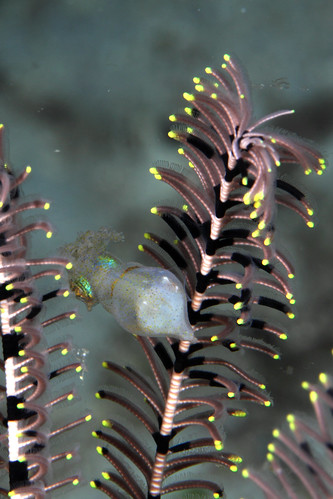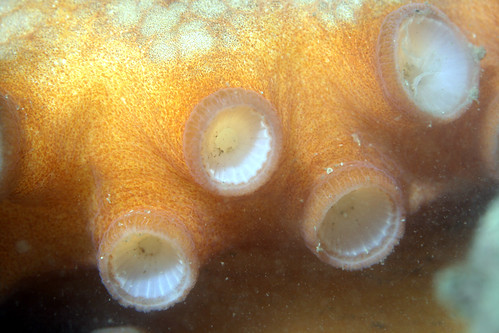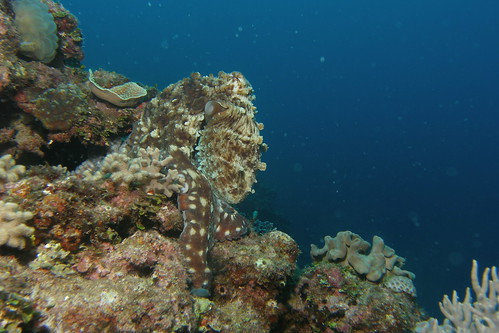I recently got a request (thanks to
arvindpillai at Fins to Feet) to do a post on the shoaling and predatory behavior of Humboldt squid,
Dosidicus gigas (also known as the Jumbo squid, and by those who
don't know any better, the giant squid.) I decided that this would be a good thing to do, because I hadn't read much about the predatory behavior of
D. gigas. So I spent a week searching the literature for scientific studies on Humboldt squid predatory behavior, and guess what? I still haven't read much about it!
It turns out that there is very little known about the behavior of these squid. The paucity of our ethological knowledge of them is shocking to me, given the disproportionate attention to this species in popular media. I've seen at least one budding cephalopod enthusiast become intrigued by stories about this species to the extent of obsession, and it's not hard to see why. Somehow, these squid have gained a reputation as fierce predators that are so bloodthirsty as to be regularly deadly to humans. As such, popular TV shows and news magazines have run numerous stories about them, usually finding one or two divers who have (presumably) had experience with these squids (or at least heard stories about them) to expound on just how ferocious and aggressive they are. Invariably, some sensational quip (that is almost always unsupported by scientific literature because, well, that literature does not exist) is used to drive home just how scary these squid are:
"It has probing arms and tooth-lined tentacles, a raptor-like beak and an insatiable craving for flesh -- any kind of flesh, even that of humans," says Pete Thomas in "
Warning lights of the sea".
Mike Bear, an otherwise anonymous diver from San Diego is
quoted in this article as saying "I wouldn't go into the water with them for the same reason I wouldn't walk into a pride of lions on the Serengeti."
“The Humboldt squid is a voracious predator that will eat anything it can get its tentacles on,” says Kelly Benoit-Bird, an oceanographer, quoted by Mark Floyd
in this piece.
With all the hubbub, these guys must be pretty dangerous, right? The stuff of nightmares, even! I mean, just look at this bloodthirsty monster!
Oh wait, it's kind of cute, isn't it?
This is the myth of the Humboldt squid: that they are first and foremost dangerous, indiscriminate killing machines. This is, frustratingly, the first (and often only) piece of information that is repeated about them in any given article. But what's the real story?
Let's put this in perspective by considering the case of sharks, another predatory ocean-dweller that has been sensationalized as being imminently dangerous to humans (remember "Jaws"? It was pretty silly, but a lot of people took that era's shark scares seriously.) Fatal shark attacks on humans are documented somewhat regularly, and are discussed (albeit infrequently) in the scientific and medical literature (ie.
this study on fatal shark attacks.) I cannot find a single verifiable record of a fatal squid attack on a human in the medical literature (admittedly, I have only searched 3 online databases and Google scholar - I might be missing something.) The closest thing I can find are fisherman's accounts in popular media of other fisherman's stories about hearing about people being killed by Humboldt squid. Keeping in mind the
D. gigas is a rather common animal, is fished for sport by casual fishermen, and is usually encountered in large groups (the commonly cited size is 1000-1200 animals per shoal, but I can't find anything peer reviewed to support this,) it looks like these squid are all but harmless, given how often it is encountered by lay-people and how few (if any) fatal encounters there have been.
This is not to say that I don't think it's possible that a Humboldt might kill a human someday; they are clearly aggressive, as several documented, non-fatal "attacks" on humans show. I have to say, though, that the media attention that is payed to them (which is probably the reason why so many people are "interested" in them) is really a nuisance. By making inflated claims about a species that we have little behavioral research about, media outlets encourage people to accept hearsay and horror stories as if they were biological fact. These stories also draw attention away from other squid species whose behavior is very well characterized (ie.
L. Pelalei) which might be better used to teach the public basic information about cephalopods. Finally, by attempting to catch people's eye using gorey stories, such articles serve to blind people to really learning about these animals by focusing on how "bloodthirsty" and "horrifying" they are - an effect that can't be any good for conservation effforts. I recognize that most people want an entertaining story rather than a dissertation out of their media, but this obvious bias in popular media coverage on this particular variety of cephalopods just bugs me because it is so pervasive and one-sided.
Now that I'm done ranting and raving, and have hopefully convinced you that
D. gigas might not be the single-minded killers that they are often portrayed to be, I'll try to get at the facts (that is, our very limited scientific knowledge) of this species. Most of the research that has been done on them has been about their interactions with predator and prey species and their movement through their habitat, rather than their ethology. This is because they are an important species in the study of ocean ecology. They can be caught regularly in relatively large numbers throughout their range with little risk of damaging populations - this is uncommon among large predators, which tend to be much more rare than those lower on the food chain. They are also suitable to be tracked using remotely monitored tags (as per Markaida et al. 2005) which are difficult to attach to less robust cephalopod species. As such, they are convenient and informative to study when trying to learn about how oceanic food chains work.
So, what do we know about their feeding habits? For one, we know that, as Dr. Benoit-Bird was trying to point out, that Humboldts are active, generalist predators, eating (according to Nigmatullin et al.) all manner of prey including "cepepods, hyperiid amphipods, euphausiids, pelagic shrimps and red crabs... heteropod molluscs, squid, pelagic octopods and various fishes." The authors also note that
D. gigas is commonly cannibalistic, a facet of their predation that has probably contributed to their mythological status. They are especially cannibalistic during squid jigging sessions, when they are excited by bright lights and surrounded by their injured conspecifics. They feed near the surface mostly during the night, especially at dusk and dawn, and spend their days deeper in the water column (200-400m deep), as was shown by a radio tracking study by Gilly et al. in 2006. They can vary their diet depending on changes in their environment, showing an adaptability that no doubt contributes to their great abundance (Markaid and Sosa-Nishizaki, 2002). Interestingly, recent ecological research has shown that their range has recently expanded from its historical locus in the equatorial Pacific ocean off of Central and South America to extend to the Pacific Northwest (as described by Cosgrove and Sendal, 2005, Zeidberg and Robison, 2007, and Field et al., 2007), possibly due to their unique ability to deal with hypoxic conditions that other predatory species cannot. The squid can retreat into deep water with very little oxygen in between daily trips to feed at the surface, and thus avoid predation by other species such as Mako sharks (Vetter et al, 2008).. On an unrelated note, if I were a squid researcher named Zeidberg, I'd just go ahead and change it to "Zoidberg". It's too perfect.
There is dissappointingly little to say about the shoaling and predatory behavior of
D. gigas. If there are any glaring omissions in my coverage of the topic, please let me know; however, I think I found most of what's in the scientific literature. Basically, we know that they form large shoals, and that they are generalist predators. More detailed information than that on the behavior of this species will have to wait for a new generation of adventurous ethologists. Until then, I'll be turning back to those species of cephalopod about which we have enough information to draw useful conclusions about behavior. Perhaps someday the sort of experiments that have been done in smaller, more easily handled species will be done in
D. gigas, but until that happens, I will probably stay mostly silent about them in favor of covering studies on less glamorous species in detail.
Please excuse me if it seems like I've rained on the proverbial parade. Excuse me also for not getting into the methods of the studies that I've cited. I encourage you to peruse them, but I opted to cover a greater area of research superficially rather than getting in depth about any specific finding in this post, so that I could adequately sum up the state of scientific knowledge of the Humboldt squid. To lighten the mood, I'll leave you with one more quote about the Humboldtl, by the realtively famous undersea cameraman, Scott Cassell, who has spent much of his professional career filming these squid (including a documentary titled "Humboldt: the Man-Eating Squid") and is quoted
in this piece by Tim Zimmermann: "They are one of the most beautiful creatures, and they just happen to be lethal... There is no life form on this planet more alien than a Humboldt squid." I guess I didn't realize that any life form on this planet was "alien", given that they all evolved here. Oh well - what do I know?
Thanks for reading!
 Gilly, W., Markaida, U., Baxter, C., Block, B., Boustany, A., Zeidberg, L., Reisenbichler, K., Robison, B., Bazzino, G., & Salinas, C. (2006). Vertical and horizontal migrations by the jumbo squid Dosidicus gigas revealed by electronic tagging Marine Ecology Progress Series, 324, 1-17 DOI: 10.3354/meps324001
JOHN C. FIELD, KEN BALTZ, A. JASON PHILLIPS, & WILLIAM A. WALKER (2007). RANGE EXPANSION AND TROPHIC INTERACTIONS OF THE JUMBO SQUID,
Gilly, W., Markaida, U., Baxter, C., Block, B., Boustany, A., Zeidberg, L., Reisenbichler, K., Robison, B., Bazzino, G., & Salinas, C. (2006). Vertical and horizontal migrations by the jumbo squid Dosidicus gigas revealed by electronic tagging Marine Ecology Progress Series, 324, 1-17 DOI: 10.3354/meps324001
JOHN C. FIELD, KEN BALTZ, A. JASON PHILLIPS, & WILLIAM A. WALKER (2007). RANGE EXPANSION AND TROPHIC INTERACTIONS OF THE JUMBO SQUID,
DOSIDICUS GIGAS, IN THE CALIFORNIA CURRENT CalCOFI Rep., 48 : http://swfsc.noaa.gov/publications/FED/00859.pdf
James A. Cosgrove, & Kelly A. Sendall (2005). First Records of Dosidicus gigas, the Humboldt Squid
in the Temperate North-eastern Pacific Archives of the British Columbia Royal Museum
Unai Markaida, Joshua J. C. Rosenthal, & William F. Gilly (2005). Tagging studies on the jumbo squid
(Dosidicus gigas) in the Gulf of California, Mexico Fisheriy Bulletin, 103, 219-226
Markaida, U., & Sosa-Nishizaki, O. (2003). Food and feeding habits of jumbo squid Dosidicus gigas (Cephalopoda: Ommastrephidae) from the Gulf of California, Mexico Journal of the Marine Biological Association of the UK, 83 (3), 507-522 DOI: 10.1017/S0025315403007434h
Nigmatullin, C. (2001). A review of the biology of the jumbo squid Dosidicus gigas (Cephalopoda: Ommastrephidae) Fisheries Research, 54 (1), 9-19 DOI: 10.1016/S0165-7836(01)00371-X
RUSS VETTER, SUZANNE KOHIN, ANTONELLA PRETI, SAM MCCLATCHIE AND HEIDI DEWAR (2008). PREDATORY INTERACTIONS AND NICHE OVERLAP BETWEEN MAKO SHARK,
ISURUS OXYRINCHUS, AND JUMBO SQUID, DOSIDICUS GIGAS, IN THE CALIFORNIA CURRENT CalCOFI Rep., 49
Zeidberg LD, & Robison BH (2007). Invasive range expansion by the Humboldt squid, Dosidicus gigas, in the eastern North Pacific. Proceedings of the National Academy of Sciences of the United States of America, 104 (31), 12948-50 PMID: 17646649
Byard RW, Gilbert JD, & Brown K (2000). Pathologic features of fatal shark attacks. The American journal of forensic medicine and pathology : official publication of the National Association of Medical Examiners, 21 (3), 225-9 PMID: 10990281
I know these citations are sloppy - for some reason, I'm having some trouble working with the ResearchBlogging citation generator. I promise I'll fix it before next time.
































.jpg)
_dark_coloration.jpg)

.jpg)

